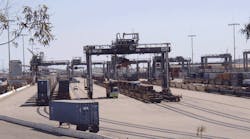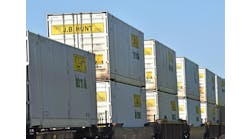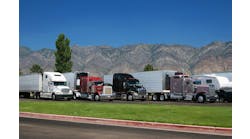If you are a shipper planning for your company's future transportation needs, the question isn't whether you will choose to turn to rail intermodal as an alternative to over-the-road hauling of your freight, but when and how much.
One reason is simple: Trucking capacity is going to shrink because of an aging driver population and new hours-of-service regulations that reduce driver productivity. This loss of capacity is already apparent on some high-traffic lanes. Although diesel prices have been low in recent months, we know how quickly that can change, which will then add skyrocketing fuel prices into a volatile mix of cost factors.
The new driver hours rules imposed in July have not yet affected trucking rates, but they have impacted productivity and the availability of trucks on some lanes, said some shippers at the joint meeting in Houston of the National Industrial Transportation League, Intermodal Association of North America and Transportation Intermediaries Association.
The Productivity Problem
Truckload carriers have reported productivity losses due to the new rules in the range of 3 to 5 percent. Schneider National, the nation's largest truckload carrier with 14,000 drivers, says it has seen a 3.1 percent decrease in productivity for shipments handled by individual drivers and a 4.3 percent productivity reduction in team operations.
Both for-hire trucking company officers and shipper executives who operate private fleets stated publicly in presentations at the Houston meeting that the driver shortage is real. They attribute this to an aging driver population that is leaving the workforce in increasing numbers, as well as to the widespread negative view of truck driving as a profession among younger people that has dampened recruitment.
Available Alternatives
At this year's joint conference, a popular tactic adopted by a number of speakers was to ask audience members to raise their hands if their children were interested in becoming truck drivers. In all of the sessions where this was done not a single hand went up.
Several speakers also noted that as soon as the housing sector improves along with the rest of the economy, they expect owner-operators will once again park their trucks and switch to working construction, where the working conditions are better and they are home every night.
But the reasons that shippers are making the switch to intermodal aren't entirely negative. They also are learning that today's rail intermodal service isn't your grandfather's piggyback. Railroads have improved the reliability of their schedules and their transit time significantly in recent years. One top trucking executive has admitted that in terms of shock and vibration the ride of cargo carried on an intermodal train is superior to that experienced with an over-the-road truck. Today, knowledgeable shippers are unafraid to regularly load sensitive cargo such as light bulbs on intermodal trains.
Intermodal's New Luster
Recent statistics bear out that smart supply chain managers are turning to intermodal in greater numbers. Rail intermodal volumes in October rose 6.8 percent, and the month's weekly average of 263,520 intermodal units is the single highest weekly average ever recorded by the Association of American Railroads. Intermodal traffic for the week ending November 3 reached a total of 264,264 trailers and containers, representing an annual increase of 17.7 percent, and a rise of 4 percent for the year to date.
Intermodal freight is the fastest growing single commodity group on major railroads, and they have become more conscientious about growing this business segment with the decline in bulk commodity traffic, particularly their former cash cow: coal. This has translated to them giving greater priority to intermodal trains, speeding up transit time and making that service more reliable.
Many savvy shippers have embraced intermodal. Speaking at a Houston session, Brad Parkhurst, transportation sourcing leader at Owens Corning Sales, said his company wants to increase its use of intermodal. Instead of its previous practice of moving into intermodal on a plant-by-plant basis, his company has evolved a company-wide strategy. "I would like to see our use of intermodal grow faster and we are working with customers to achieve that."
Know the Pros and Cons
As users of domestic intermodal services have learned, even with improved service if you are a shipper who wants to add intermodal to your transportation, you should plan carefully and understand that flexibility will be key to any plan you make.
"You have to know the pros and cons," says Paul Delp, president of Lansdale Warehouse Co., a warehouse-based third-party logistics provider serving Pennsylvania and the Mid-Atlantic, who also is president of the American Chain of Warehouses Inc. "The pros are that you should see some better pricing, but you need to plan for a longer transit time. You may need to adjust some of your safety stock and carry a little bit more inventory."
Jere Van Puffelen, president of Prism Team Logistics, another warehouse-based 3PL that serves northern California and its ports, notes that while there is a cost advantage for intermodal linehaul transportation, additional cost arises from the preparation of either the container or piggyback trailer. "Typically it has to be loaded a little bit differently and takes a bit more time than if you are just loading an over-the-road truck," he observes.
"When you switch your network from over-the-road to intermodal, you have to build in more capacity on the distribution side," Van Pufflen adds. "In order to respond to your market and your customers, that's going to push towards having more warehouse locations because you will be doing more of the local and regional pickup and delivery—the final mile work would be done out of a regional or local inventory as opposed to what happens when you use LTL."
Other Service Providers
He said that is one reason why shippers turn to warehouse companies like his, which are frequently located on spur lines and have their own sidings, and which boast decades of experience in dealing with railroads and intermodal shipments. In addition, Van Puffelen says, "when you look at the capital investment it requires to run your own trucking and warehousing, and the labor and driver management issues, it's just not a wise investment for manufacturers, who prefer investing in better manufacturing processes, where they can get a lot more return than they can from running trucks or operating a warehouse."
Both Van Puffelen and Jim Filter, senior vice president, Intermodal Commercial Management for Schneider National, say the first thing they do when discussing intermodal alternatives with customers is to educate them about the range of services available and the improved speed of intermodal trains.
Filter says that Schneider National also frequently partners with warehouse-based 3PLs. "We see those as customers of ours whom we work with, the way that we augment our services. We provide over-the-road, dedicated, third-party brokered services so as the supply chain changes we switch loads from intermodal to truckload or third-party and it's seamless to the customer."
Truckload's the Alternative to Intermodal
Once customers become experienced with using intermodal and are persuaded that is the equivalent of truckload in terms of service quality, he says they cease seeing it as an alternative to truckload, and instead start viewing truckload as an alternative to intermodal, Filter notes. Schneider National has further encouraged this way of thinking by adding the same satellite tracking available for years on truck trailers to its domestic containers.
Only about 50 percent of freight that should go intermodal is going intermodal, according to Filter. "We're able to work directly with customers to look at their existing business and identify opportunities for conversion. Once customers make that step, after a certain period of time they start to look at their business differently. Instead of looking for opportunities to convert freight from truckload to intermodal, they start with the assumption that ‘I'm going to put everything on intermodal and it only goes on trucking if I have a compelling reason to do so.'"
Only a few years ago the rule of thumb was that rail intermodal was economically competitive with truckload service only for hauls above 1,000 miles. That has changed, too. "My personal opinion is that anybody who is shipping more than 500 miles needs to look at intermodal as an option," says Scott Menzies, president of Terminal Corporation, another warehouse-based 3PL that serves the Mid-Atlantic from the Port of Baltimore, along with offering service in Houston, Los Angeles, Savannah and New Orleans through other third parties in those cities.
"You really need to look at this on a lane-by-lane basis because the rail networks have changed," he says. "There are lanes where we are operating at essentially the same transit time as truckload. There isn't a simple formula that says, ‘I will always have one additional day of transit and that's what it is' because there have been so many improvements in intermodal. As we see capacity reductions in truckload, you really have to look how it is truly operating rather than just the stated transit times."
Watch Seasonal Changes
Shippers also should keep a close eye on cargo movements that fluctuate with the seasons, creating imbalances in intermodal transportation networks that can create opportunities for cost reductions, Menzies says.
"For example, you get seasonality with temperature-controlled equipment, or beer, wine and spirits shipments, where 80 percent of their sales occur in the third and fourth quarters of the year," he points out. "With that product moving from the West to the East Coast you can use all the intermodal equipment looking for something to pay its way back. Locating those imbalances can give shippers some real opportunities to save freight costs."
Transloading's Value
Another factor for planning to move overseas shipments domestically via rail is the availability of a practice that many shippers are still unaware of called transloading, which is a common service offering among asset-based service providers like 3PL warehouses and Schneider. This is where a container is unloaded and the contents reloaded into another container or trailer for delivery via rail intermodal or truck.
"This service is particularly valuable when a service provider is located near a port—or works with one that is—because the ocean carriers don't want their containers going too far inland or to the Midwest," Menzies notes. "They want to keep those assets as close to the port as possible, which creates a natural opportunity for intermodal transloads."
David Sparkman is founding editor of ACWI Advance (www.acwi.org), the newsletter of the American Chain of Warehouses Inc.



